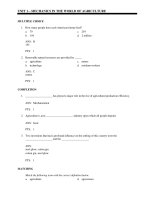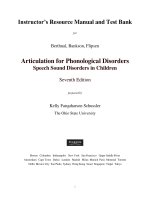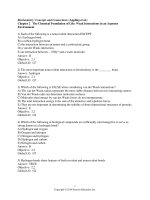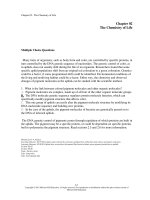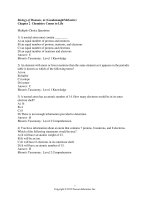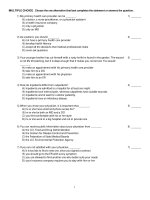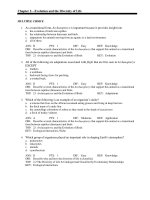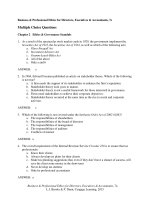Cell and molecular biology concepts and experiments 7th edition karp test bank
Bạn đang xem bản rút gọn của tài liệu. Xem và tải ngay bản đầy đủ của tài liệu tại đây (415.68 KB, 23 trang )
Package Title: Test Bank
Course Title: Karp7e
Chapter Number: 2
Question Type: Multiple Choice
1) Which of the groups below is capable of only hydrophobic interactions?
OH
a..
d.
b.
CH 2
OH
H
H
SH H
H
C
C
C
C
C
H
H
H
H
H
e..
CH 3
H
H
H
H
C
C
C
H
H
H
c..
H
H
CH 2
C
C
C
H
H
NH 2
H
a) A
b) B
c) C
d) D
e) E
Answer: e
Difficulty: Medium
Learning Objective: LO 2.2 Describe non-colvalent bonding, giving examples.
Section Reference: Section 2.2 Noncovalent Bonds
2) Which of the following groups is capable of only hydrophilic interactions?
CH 3
a.
H
H
H
H
H
C
C
C
C
C
H
H
H
H
H
d.
OH
H
b.
c.
C
O
OH
e.
a) A
b) B
Page 1
H
H
C
C
C
C
H
H
SH
H
H
NH 2
C
C
C
H
H
OH
H
O
H
H
c) C
d) D
e) E
Answer: b
Difficulty: Medium
Learning Objective: LO 2.2 Describe non-colvalent bonding, giving examples.
Section Reference: Section 2.2 Noncovalent Bonds
3) Which of the following tripeptides would be most likely to be soluble in an organic (hydrophobic)
solvent like benzene?
a) N - phenylalanine - alanine - glycine – C
b) N - leucine - alanine - lysine - C
c) N - proline - phenylalanine - leucine - C
d) N - arginine - lysine - proline - C
e) N - glutamate - aspartate - glycine – C
Answer: c
Difficulty: Hard
Learning Objective: LO 2.5 Define the four types of biological molecules, their monomers, their
syntheses, and their function in the cell.
Section Reference: Section 2.5 Four Types of Biological Molecules
4) What kind of bond results from an unequal sharing of electrons?
a) ionic bond
b) polar covalent bond
c) H bond
d) nonpolar covalent bond
Answer: b
Difficulty: Easy
Learning Objective: LO 2.1 Define what a covalent bond is, elaborating on polar and non-polar
molecules.
Section Reference: Section 2.1 Covalent Bonds
5) Under which circumstances would electrons be most likely to be shared equally?
a) when they are equidistant from nuclei
b) when they are equidistant from each other
c) when atoms of the same element are sharing them
d) when the atoms sharing them are different
Answer: c
Page 2
Difficulty: Easy
Learning Objective: LO 2.1 Define what a covalent bond is, elaborating on polar and non-polar
molecules.
Section Reference: Section 2.1 Covalent Bonds
6) The most electronegative atoms typically present in biological molecules are ____ and ____.
a) O, C
b) O, P
c) O, N
d) C, N
e) C, Na
Answer: c
Difficulty: Easy
Learning Objective: LO 2.1 Define what a covalent bond is, elaborating on polar and non-polar
molecules.
Section Reference: Section 2.1 Covalent Bonds
7) The most stable atoms and thus those that are typically nonreactive are the atoms that have _______.
a) equal numbers of electrons and protons
b) equal numbers of electrons and neutrons
c) full inner shells
d) full outer shells
e) all covalent bonds
Answer: d
Difficulty: Easy
Learning Objective: LO 2.1 Define what a covalent bond is, elaborating on polar and non-polar
molecules.
Section Reference: Section 2.1 Covalent Bonds
8) Why are free ionic bonds of little importance and relatively unlikely to form in living organisms?
1)Cells are composed mostly of water, which interferes with ionic bonds between free ions.
2)Cells are largely hydrophobic.
3)They are crystals.
a) 1
b) 2
c) 3
d) 1 and 2
e) 2 and 3
Answer: a
Page 3
Difficulty: Easy
Learning Objective: LO 2.2 Describe non-colvalent bonding, giving examples.
Section Reference: Section 2.2 Noncovalent Bonds
9) In a living organism, where are ionic bonds most likely to be found?
a) in the cytoplasm
b) between DNA strands
c) deep in a protein's core where water is excluded
d) on the surface of a protein
e) on the surface of a lipid
Answer: c
Difficulty: Medium
Learning Objective: LO 2.2 Describe non-colvalent bonding, giving examples.
Section Reference: Section 2.2 Noncovalent Bonds
10) Which interaction is most important in enhancing the solubility of macromolecules in water?
a) hydrophobic interactions
b) nonpolar covalent bonds
c) H bonds
d) van der Waals forces
e) Both hydrophobic interactions and nonpolar covalent bonds
Answer: c
Difficulty: Medium
Learning Objective: LO 2.2 Describe non-colvalent bonding, giving examples.
Section Reference: Section 2.2 Noncovalent Bonds
11) Where are hydrophobic interactions most likely to occur?
a) on the surface of a water-soluble protein
b) the core of a water-soluble protein
c) in contact with water molecules
d) between two charged molecules
e) between two ions
Answer: b
Difficulty: Easy
Learning Objective: LO 2.2 Describe non-colvalent bonding, giving examples.
Section Reference: Section 2.2 Noncovalent Bonds
Page 4
12) What kind of noncovalent interaction is typified by interactions between two molecules that are so
close together that they can experience weak attractive forces bonding them together?
a) H bonds
b) ionic bonds
c) hydrophobic interactions
d) polar covalent bonds
e) van der Waals forces
Answer: e
Difficulty: Medium
Learning Objective: LO 2.2 Describe non-colvalent bonding, giving examples.
Section Reference: Section 2.2 Noncovalent Bonds
13) A molecule that is capable of releasing or donating a hydrogen ion is termed a(n) _______.
a) base
b) hydrion
c) acid
d) anachronism
e) pain
Answer: c
Difficulty: Easy
Learning Objective: LO 2.3 Compare and contrast acids, bases, and buffers, discussing their properties
and applications.
Section Reference: Section 2.3 Acids, Bases, and Buffers
14) A release of hydrogen ions to a solution would most likely ____________.
a) raise pH
b) lower pH
c) buffer pH
d) change salinity
e) keep pH steady
Answer: b
Difficulty: Easy
Learning Objective: LO 2.3 Compare and contrast acids, bases, and buffers, discussing their properties
and applications.
Section Reference: Section 2.3 Acids, Bases, and Buffers
15) Why is silicon not suitable for making covalent bonds stable and strong enough to form the basis of
living organisms, even though it is just below carbon on the periodic table?
Page 5
a) Silicon is too large for its nucleus to attract the valence electrons of neighboring atoms enough to hold
molecules together sufficiently.
b) Silicon is too small for its nucleus to attract the valence electrons of neighboring atoms enough to hold
molecules together sufficiently.
c) Silicon is too large for its nucleus to attract the protons of neighboring atoms enough to hold molecules
together.
d) Silicon is too small for its nucleus to attract the protons of neighboring atoms enough to hold
molecules together.
Answer: a
Difficulty: Hard
Learning Objective: LO 2.1 Define what a covalent bond is, elaborating on polar and non-polar
molecules.
Section Reference: Section 2.1 Covalent Bonds
16) The low-molecular-weight building blocks of polymers are called _______.
a) minipolymers
b) monoblocks
c) monomers
d) portions
e) octamers
Answer: c
Difficulty: Easy
Learning Objective: LO 2.4 Describe the seven functional groups, discussing how each structure would
affect its solubility in water.
Section Reference: Section 2.4 The Nature of Biological Molecules
17) What bond is responsible for the branch points in glycogen and amylopectin?
a) (1—>4) glycosidic linkages
b) (1—>4) glycosidic linkages
c) (1—>6) glycosidic linkages
d) (1—>6) glycosidic linkages
e) 3'-5' phosphodiester linkages
Answer: c
Difficulty: Medium
Learning Objective: LO 2.5 Define the four types of biological molecules, their monomers, their
syntheses, and their function in the cell.
Section Reference: Section 2.5 Four Types of Biological Molecules
18) Which polysaccharide bond cannot be broken by mammalian enzymes that normally digest
Page 6
polysaccharides?
a) (1—>4) glycosidic linkages
b) (1—>4) glycosidic linkages
c) (1—>6) glycosidic linkages
d) (1—>6) glycosidic linkages
e) phosphate ester linkages
Answer: b
Difficulty: Hard
Learning Objective: LO 2.5 Define the four types of biological molecules, their monomers, their
syntheses, and their function in the cell.
Section Reference: Section 2.5 Four Types of Biological Molecules
19) Why do sugars tend to be highly water soluble?
a) because they have only a few hydroxyl groups
b) because of their large numbers of hydroxyl groups
c) because of their large numbers of sulfhydryl groups
d) because of their large numbers of methyl groups
e) because of their small molecular weights
Answer: b
Difficulty: Medium
Learning Objective: LO 2.5 Define the four types of biological molecules, their monomers, their
syntheses, and their function in the cell.
Section Reference: Section 2.5 Four Types of Biological Molecules
20) Which of the following is not a macromolecule formed by polymerization?
a) proteins
b) lipids
c) polynucleotides
d) polysaccharides
e) DNA
Answer: b
Difficulty: Hard
Learning Objective: LO 2.5 Define the four types of biological molecules, their monomers, their
syntheses, and their function in the cell.
Section Reference: Section 2.5 Four Types of Biological Molecules
21) What is the maximum number of 100 amino acid long polypeptides that could be made?
Page 7
a) 10020
b) 2,000
c) 20100
d) 20101
e) 20
Answer: c
Difficulty: Hard
Learning Objective: LO 2.5 Define the four types of biological molecules, their monomers, their
syntheses, and their function in the cell.
Section Reference: Section 2.5 Four Types of Biological Molecules
22) How do amino acids like hydroxylysine and thyroxine, which are not among the 20 amino acids that
are inserted into proteins, get into proteins?
a) They are inserted directly.
b) They are the result of the alteration of R groups of the 20 amino acids after their incorporation into the
polypeptide.
c) They are the result of the alteration of R groups of the 20 amino acids before their incorporation into
the polypeptide.
d) There are more than the 20 amino acids that are said to be inserted into proteins.
e) Their atoms are altered by insertion into the polypeptide.
Answer: b
Difficulty: Medium
Learning Objective: LO 2.5 Define the four types of biological molecules, their monomers, their
syntheses, and their function in the cell.
Section Reference: Section 2.5 Four Types of Biological Molecules
23) Which amino acid is most likely to be found in the core of a protein?
a) methionine
b) asparagine
c) serine
d) threonine
e) glutamic acid
Answer: a
Difficulty: Medium
Learning Objective: LO 2.5 Define the four types of biological molecules, their monomers, their
syntheses, and their function in the cell.
Section Reference: Section 2.5 Four Types of Biological Molecules
24) What type of protein secondary structure is characterized as being highly extensible because of its
coiled structure?
Page 8
a) -pleated sheet
b) double helix
c) -helix
d) supercoiling
Answer: c
Difficulty: Medium
Learning Objective: LO 2.5 Define the four types of biological molecules, their monomers, their
syntheses, and their function in the cell.
Section Reference: Section 2.5 Four Types of Biological Molecules
25) The -pleated sheet is characterized by orientation of ______ the molecular axis.
a) H bonds parallel to
b) H bonds perpendicular to
c) ionic bonds parallel to
d) ionic bonds perpendicular to
e) peptide bonds perpendicular to
Answer: b
Difficulty: Easy
Learning Objective: LO 2.5 Define the four types of biological molecules, their monomers, their
syntheses, and their function in the cell.
Section Reference: Section 2.5 Four Types of Biological Molecules
26) Proteins are often composed of two or more distinct modules that fold up independently of one
another. They often represent parts of a protein that function in a semi-independent manner. These
modules are called ______.
a) protein motifs
b) functionals
c) domains
d) dominoes
Answer: c
Difficulty: Easy
Learning Objective: LO 2.5 Define the four types of biological molecules, their monomers, their
syntheses, and their function in the cell.
Section Reference: Section 2.5 Four Types of Biological Molecules
27) What level of structure in proteins is held together by intermolecular R group interactions?
a) primary structure
b) secondary structure
Page 9
c) tertiary structure
d) quaternary structure
Answer: d
Difficulty: Medium
Learning Objective: LO 2.5 Define the four types of biological molecules, their monomers, their
syntheses, and their function in the cell.
Section Reference: Section 2.5 Four Types of Biological Molecules
28) Which of the following is a nucleotide?
a) phosphate + ribose
b) adenine + deoxyribose
c) sugar + nitrogenous base
d) adenine + ribose + phosphate
Answer: d
Difficulty: Medium
Learning Objective: LO 2.5 Define the four types of biological molecules, their monomers, their
syntheses, and their function in the cell.
Section Reference: Section 2.5 Four Types of Biological Molecules
29) Tertiary structure in DNA is also known as ________.
a) primary structure
b) supercoiling
c) double helix
d) -helix
Answer: b
Difficulty: Easy
Learning Objective: LO 2.5 Define the four types of biological molecules, their monomers, their
syntheses, and their function in the cell.
Section Reference: Section 2.5 Four Types of Biological Molecules
30) What is now thought to have been the genetic material in the first living organisms on Earth?
a) RNA
b) DNA
c) protein
d) polypeptides
Answer: a
Difficulty: Easy
Page 10
Learning Objective: LO 2.5 Define the four types of biological molecules, their monomers, their
syntheses, and their function in the cell.
Section Reference: Section 2.5 Four Types of Biological Molecules
Question Type: Essay
31) Which of the groups below is capable of only hydrophobic interactions? Explain your answer.
Which is capable of only hydrophilic interactions? Explain your answer.
a.
H H
H
H
H
C C
C
C
C
H H
H
H
H
H
OH
d.
b.
H
e.
N H
H
H
NH 2
C
C
C
H
H
OH
c.
H
H
OH
C O
C
C
C
H
H
SH
H
H
Answer:
Difficulty: Medium
Learning Objective: LO 2.2 Describe non-colvalent bonding, giving examples.
Section Reference: Section 2.2 Noncovalent Bonds
Solution: A is capable of only hydrophobic interactions. It contains no ionizable or hydrophilic groups.
B is capable of only hydrophilic interactions, since it has no component with a long carbon chain or a
carbon-containing ring and no nonpolar covalent linkages. It is also capable of ionization.
32) You treat a partially purified preparation of protein with a reagent that breaks bonds between sulfur
atoms. Which level(s) of protein structure are likely to be affected the most?
Answer:
Difficulty: Medium
Learning Objective: LO 2.5 Define the four types of biological molecules, their monomers, their
syntheses, and their function in the cell.
Section Reference: Section 2.5 Four Types of Biological Molecules
Solution: Both the tertiary and quaternary levels of structure would be affected since those levels are the
only ones in which disulfide bonds are prominent.
33) Not all proteins are able to renature. Some proteins when exposed to heat or some other denaturing
treatment are irreversibly denatured. What is an example of such a protein?
Answer:
Difficulty: Easy
Learning Objective: LO 2.5 Define the four types of biological molecules, their monomers, their
syntheses, and their function in the cell.
Page 11
Section Reference: Section 2.5 Four Types of Biological Molecules
Solution: Egg white protein and yolk are examples of proteins that are irreversibly denatured by heat.
34) You are working with an enzyme altase that you denature in the presence of urea. If altase were
denatured no further by the addition of mercaptoethanol, what would that suggest to you about the
enzyme?
Answer:
Difficulty: Medium
Learning Objective: LO 2.5 Define the four types of biological molecules, their monomers, their
syntheses, and their function in the cell.
Section Reference: Section 2.5 Four Types of Biological Molecules
Solution: The enzyme probably contained no disulfide linkages since mercaptoethanol breaks such
linkages.
35) Would all proteins be likely to require exposure to mercaptoethanol in order to accomplish full
denaturation? If not, what trait would a protein that did not require mercaptoethanol possess?
Answer:
Difficulty: Medium
Learning Objective: LO 2.5 Define the four types of biological molecules, their monomers, their
syntheses, and their function in the cell.
Section Reference: Section 2.5 Four Types of Biological Molecules
Solution: Not all proteins would require mercaptoethanol to accomplish full denaturation. If a protein
has no disulfide linkages, it probably would not require mercaptoethanol for full denaturation.
36) An enzyme is placed in a solution containing urea. Assuming that this protein contains no disulfide
linkages, is it reasonable to suspect that it will be totally denatured by the treatment? How could you
know that the enzyme has, in fact, been denatured? Why does the urea denature the tertiary structure of
the enzyme?
Answer:
Difficulty: Hard
Learning Objective: LO 2.5 Define the four types of biological molecules, their monomers, their
syntheses, and their function in the cell.
Section Reference: Section 2.5 Four Types of Biological Molecules
Solution: Placement in a urea solution should totally denature the enzyme, especially since there are no
disulfide linkages. If there are extensive hydrophobic interactions between enzyme R groups, total
denaturation may be difficult to accomplish. If the enzyme activity disappears, there is a good chance
the enzyme has been denatured. Urea breaks up the tertiary structure by interfering with hydrophilic
interactions, like H bonds.
37) Which of the following tripeptides would be most likely to be soluble in an organic (hydrophobic)
solvent like benzene: N - phenylalanine - alanine - glutamine - C, N - leucine - alanine - lysine - C, N -
Page 12
proline - phenylalanine - leucine - C, N - arginine - lysine - proline - C, N - glutamate - aspartate - glycine
- C? Explain your answer.
Answer:
Difficulty: Medium
Learning Objective: LO 2.5 Define the four types of biological molecules, their monomers, their
syntheses, and their function in the cell.
Section Reference: Section 2.5 Four Types of Biological Molecules
Solution: N - proline - phenylalanine - leucine - C would be most soluble in a hydrophobic solvent. All
three amino acids are classed as nonpolar amino acids and could be soluble in benzene. In the other
tripeptides, at least one of the amino acids does not belong to the nonpolar class.
38) What level of structure in DNA would be disrupted by a reagent that breaks apart hydrogen bonds?
Answer:
Difficulty: Hard
Learning Objective: LO 2.5 Define the four types of biological molecules, their monomers, their
syntheses, and their function in the cell.
Section Reference: Section 2.5 Four Types of Biological Molecules
Solution: Secondary structure would be disrupted, because it is held together by hydrogen bonds.
Hydrogen bonds are also involved in tertiary and quaternary structure. Thus, such a reagent would also
disrupt these levels of structure in areas where H bonds are involved.
39) DNA is isolated from two different species. Both DNA samples are found to be the same size. One
of the DNA samples has a G+C/A+T ratio of 2.0 and the other 2.5. Which DNA sample has a higher
G+C content? Which sample contains the smallest number of H bonds between strands? Which DNA
sample would be easiest to denature?
Answer:
Difficulty: Medium
Learning Objective: LO 2.5 Define the four types of biological molecules, their monomers, their
syntheses, and their function in the cell.
Section Reference: Section 2.5 Four Types of Biological Molecules
Solution: The second sample has the higher G+C content, since the G+C/A+T ratio for that sample is the
largest. The first sample contains a larger amount of A+T. Since A-T base pairs make only 2 H bonds,
while G-C base pairs make three, the sample with the most A-T base pairs would have the fewest H
bonds.
The first sample would be the easiest to denature, since it is held together with the smallest
number of H bonds.
40) Mammals lack the enzyme that hydrolyzes cellulose. Yet many mammals are herbivores and they
eat grass and other plant material for nutrition. How can this be, given that they cannot digest the food
they are eating?
Answer:
Page 13
Difficulty: Easy
Learning Objective: LO 2.5 Define the four types of biological molecules, their monomers, their
syntheses, and their function in the cell.
Section Reference: Section 2.5 Four Types of Biological Molecules
Solution: While these animals lack the enzyme that digests cellulose, bacteria that reside within their
digestive tracts possess it. There is a symbiotic relationship between the two organisms. The herbivores
seek out and eat the grass; the bacteria in their digestive tract digest it. What the bacteria don't use, the
herbivore does.
41) You are a crew member on the starship Enterprise. Your responsibilities include investigation of
biological life forms. You take out your tricorder after landing on the planet Yamihere and find a
number of organisms, all of which contain DNA that follows the nitrogenous base pairing rules you are
familiar with on Earth. For one species, the following relationships hold for the organism's DNA.
moles of adenine = 8
A+T
2
G+C
How many moles of guanine are present?
How many moles of thymine are present?
How many moles of uracil are present?
You isolate DNA from another organism living on the surface of Yamihere and find that it contains all the
bases normally found in DNA, but does not obey the pairing rules. Can you explain these strange
results?
Answer:
Difficulty: Hard
Learning Objective: LO 2.5 Define the four types of biological molecules, their monomers, their
syntheses, and their function in the cell.
Section Reference: Section 2.5 Four Types of Biological Molecules
Solution: 4 moles of guanine, 8 moles of thymine and 0 moles of uracil (There is no uracil in DNA.) are
present. One possible explanation is that the DNA is single-stranded.
42) What are some possible explanations for the branched structure of glycogen?
Answer:
Difficulty: Medium
Learning Objective: LO 2.5 Define the four types of biological molecules, their monomers, their
syntheses, and their function in the cell.
Section Reference: Section 2.5 Four Types of Biological Molecules
Solution: First, branching allows more efficient storage of energy. More glucose monomers can be
stored in a smaller space. Second, branching creates more free ends on the structure. This would allow
glycogen to be disassembled more rapidly when free glucose is needed and would also allow quicker
assembly when glycogen is being constructed.
Page 14
43) Scientists have sequenced proteins by using specific proteases to "clip" a purified protein preparation
between two specific amino acids, thus forming a number of moderately sized fragments; they have used
acid hydrolysis to produce smaller fragments. Each fragment can then be sequenced by breaking the
moderate fragments into dipeptides that are easily sequenced. The fragments below are obtained after
the initial enzymatic cleavages. Can you deduce the sequence of the original polypeptide? (HINT: the
original cleavages at specific locations differ depending on which proteolytic enzyme was used to create
each fragment; this causes an overlap in the fragments' sequences.) The final polypeptide should have 18
amino acid residues.
N - ala - ala - gluN - aspN - met - C
N - iso - pro - aspA - try - thr - C
N - met - cys - leu - lys - phe - arg - aspA - C
N - aspN - met - cys - leu - lys - C
N - aspA - try - thr - phe - tyr - ala - ala - C
Answer:
Difficulty: Hard
Learning Objective: LO 2.5 Define the four types of biological molecules, their monomers, their
syntheses, and their function in the cell.
Section Reference: Section 2.5 Four Types of Biological Molecules
Solution: N- iso - pro - aspA - try - thr - phe - tyr - ala - ala - gluN - aspN - met - cys - leu - lys - phe - arg
- aspA - C
44) Many so-called temperature-sensitive mutations have been discovered in a wide variety of organisms.
These are proteins that are non-functional at higher temperatures, while, at lower temperatures (often just
a few degrees lower), they function normally. For example, the coloration patterns in Siamese Cats arise
from a temperature-sensitive mutation. An enzyme required for the synthesis of dark pigment is unable
to function in areas close to the body where normal physiological temperatures prevail. However, at the
tips of the ears, paws, the tip of the tail and other extremities where the temperature is slightly lower, the
enzyme works correctly and dark pigment is produced. What is happening at the molecular level that
explains this?
Answer:
Difficulty: Easy
Learning Objective: LO 2.5 Define the four types of biological molecules, their monomers, their
syntheses, and their function in the cell.
Section Reference: Section 2.5 Four Types of Biological Molecules
Solution: In warmer areas of the organism, the temperature is just high enough to denature the enzyme in
question. Since it is denatured, it will not work properly and dark pigment will not be produced in those
areas.
45) You are studying a protein. It binds to elongating polypeptide chains as they emerge from an exit
channel within the ribosome's large subunit. It appears to prevent partially formed or nascent
polypeptides from binding to other proteins in the cytosol, which might cause them either to aggregate or
misfold. What kind of proteins is this likely to be? Another protein you are studying picks up larger
proteins from Hsp70 family proteins. It is a cylindrical protein complex that contains chambers in which
newly synthesized polypeptides can fold without interference from other cellular macromolecules. What
is this protein called?
Page 15
Answer:
Difficulty: Hard
Learning Objective: LO 2.5 Define the four types of biological molecules, their monomers, their
syntheses, and their function in the cell.
Section Reference: Section 2.5 Four Types of Biological Molecules
Solution: A chaperone of the Hsp70 family. It is called a chaperonin. One chaperonin, TRiC, is
thought to assist in the folding of up to 15% of the polypeptides synthesized in mammalian cells.
46) It is thought that most human diseases leave telltale patterns among the thousands of proteins present
in the blood or other bodily fluids. It was hoped that analysis of the proteins present in the blood would
help in the diagnosis of human disease; however, thus far, searches for these proteins in blood or bodily
fluids have been largely unsuccessful and their use in diagnostics largely unreliable. What are these
telltale patterns of proteins called?
Answer:
Difficulty: Easy
Learning Objective: LO 2.5 Define the four types of biological molecules, their monomers, their
syntheses, and their function in the cell.
Section Reference: Section 2.5 Four Types of Biological Molecules
Solution: Biomarkers
47) Some proteins have multiple binding partners. In some cases, they have several different binding
interfaces and they are thus capable of binding a number of different binding partners at the same time.
On the other hand, other such proteins have a single binding interface, which is capable of binding several
different partners, but only one at a time. They can play central roles in such processes as cell division
and gene expression. What are such proteins called?
Answer:
Difficulty: Easy
Learning Objective: LO 2.5 Define the four types of biological molecules, their monomers, their
syntheses, and their function in the cell.
Section Reference: Section 2.5 Four Types of Biological Molecules
Solution: Hub proteins
48) What does the compound, 2-phenylaminopyrimidine, inhibit? It was determined that
2-phenylaminopyrimidine would not have made a very effective drug. Why? What is the basis of
Gleevec's effectiveness as a drug in the treatment of chronic myelogenous leukemia (CML)? Why do
some patients taking Gleevec experience a recurrence of their cancer even though they initially went into
remission?
Answer:
Difficulty: Medium
Learning Objective: LO 2.5 Define the four types of biological molecules, their monomers, their
Page 16
syntheses, and their function in the cell.
Section Reference: Section 2.5 Four Types of Biological Molecules
Solution: It inhibits tyrosine kinases. It was a weak enzyme inhibitor, which meant that it would have
had to be used in very large quantities. Tyrosine kinases are often involved in the transformation of
normal cells into cancer cells. The development of CML is driven almost single-handedly by the presence
of an overactive tyrosine kinase called ABL. Gleevec binds tightly to the inactive form of the ABL
tyrosine kinase and prevents the enzyme from being activated, which is a necessary step if the cell is to
become cancerous. Thus, the drug can put CML patients into remission. The ABL kinase becomes
resistant to the drug, thus abrogating its effectiveness as a treatment for CML.
49) What kinds of conditions can cause free radicals?
Answer:
Difficulty: Medium
Learning Objective: LO 2.2 Describe non-colvalent bonding, giving examples.
Section Reference: Section 2.2 Noncovalent Bonds
Solution: Free radicals may form when a covalent bond is broken such that each atom that had
participated in the bond retained one of the two shared electrons that comprised the bond. They may also
form when an atom or molecule accepts a single electron transferred during an oxidation - reduction
reaction. Water, for example, can be converted into free radicals when exposed to solar radiation.
50) Why are free radicals capable of altering molecules, such as proteins, nucleic acids and lipids?
Answer:
Difficulty: Easy
Learning Objective: LO 2.2 Describe non-colvalent bonding, giving examples.
Section Reference: Section 2.2 Noncovalent Bonds
Solution: They are extremely reactive, which makes them well suited for chemically altering these
molecules. The formation of hydroxyl radicals is probably a major reason that sunlight is so damaging to
the skin.
51) What enzyme is responsible for the destruction of a type of free radical formed when molecular
oxygen picks up an extra electron?
Answer:
Difficulty: Easy
Learning Objective: LO 2.2 Describe non-colvalent bonding, giving examples.
Section Reference: Section 2.2 Noncovalent Bonds
Solution: Superoxide dismutase
52) Why is hydrogen peroxide often used as a disinfectant and bleaching agent? How do cells generally
rid themselves of hydrogen peroxide?
Answer:
Page 17
Difficulty: Medium
Learning Objective: LO 2.2 Describe non-colvalent bonding, giving examples.
Section Reference: Section 2.2 Noncovalent Bonds
Solution: Hydrogen peroxide is a potentially reactive oxidizing agent. If it is not rapidly destroyed,
hydrogen peroxide can break down to form hydroxyl radicals that attack the cell's macromolecules.
Hydrogen peroxide is normally destroyed in the cell by the enzymes catalase or glutathione peroxidase.
53) What is some specific evidence that demonstrates the importance of superoxide dismutase in getting
rid of superoxide free radicals?
Answer:
Difficulty: Hard
Learning Objective: LO 2.2 Describe non-colvalent bonding, giving examples.
Section Reference: Section 2.2 Noncovalent Bonds
Solution: Mutant bacteria and yeast cells that lack SOD activity are unable to grow in the presence of
oxygen. Furthermore, mice that lack the mitochondrial version of the enzyme (SOD2) are not able to
survive more than a week or so after birth. Conversely, mice that have been genetically engineered so
that their mitochondria contain elevated levels of the H2O2–destroying enzyme catalase live 20% longer
than untreated controls.
54) Why might an organism that had functional SOD but mutant catalase and/or glutathione peroxidase
be at a disadvantage?
Answer:
Difficulty: Hard
Learning Objective: LO 2.2 Describe non-colvalent bonding, giving examples.
Section Reference: Section 2.2 Noncovalent Bonds
Solution: SOD converts two superoxide free radicals and two hydrogen ions into hydrogen peroxide and
oxygen. Hydrogen peroxide is also a highly destructive substance and without catalase and glutathione
peroxidase, the organism would be less able to get rid of it.
55) You isolate superoxide dismutase from two cell culture lines. One of the lines (SOD1) has a level of
SOD activity similar to that found in liver, the tissue from which the cell line was originally obtained.
The other cell line (SOD10) has elevated SOD activity. The enzyme in SOD10 is extremely efficient at
converting the superoxide free radical to hydrogen peroxide. In a routine check of other critical enzyme
activities, catalase was found to have activity levels that were severely depressed in SOD10, while they
appeared normal in SOD1. Observations of SOD10 reveal that this cell line cannot be maintained as
easily as SOD1. SOD10 cells appear to die at an accelerated rate. What, if anything, can you conclude
from these data?
Answer:
Difficulty: Medium
Learning Objective: LO 2.2 Describe non-colvalent bonding, giving examples.
Section Reference: Section 2.2 Noncovalent Bonds
Page 18
Solution: While SOD10 is very efficient at neutralizing superoxide free radicals by producing hydrogen
peroxide, the peroxide is toxic in its own right. SOD10 also has a relatively ineffective catalase, which
detoxifies hydrogen peroxide. Thus, SOD10 builds up hydrogen peroxide rapidly, but lacks the ability to
neutralize it just as rapidly. The result is that these cells die at an accelerated rate.
56) What is a randomized, double-blind, placebo-controlled study?
Answer:
Difficulty: Medium
Learning Objective: LO 2.2 Describe non-colvalent bonding, giving examples.
Section Reference: Section 2.2 Noncovalent Bonds
Solution: Patients are randomly divided into two groups that are treated similarly except that one group is
given the curative factor being investigated and the other group is given a placebo (an inactive substance
that has no therapeutic value). In a double-blind study, neither the researchers nor the patients know who
is receiving treatment and who is receiving the placebo.
57) Given what you have learned about SOD, what do you hypothesize would happen to fruit flies that
have been genetically engineered to produce large amounts of SOD? Why might houseflies that are kept
caged and unable to fly live longer than those allowed to fly?
Answer:
Difficulty: Hard
Learning Objective: LO 2.2 Describe non-colvalent bonding, giving examples.
Section Reference: Section 2.2 Noncovalent Bonds
Solution: Fruit flies genetically engineered to produce large amounts of SOD should live longer than
untreated controls. Flying requires a lot of energy and thus high metabolic rates. A fly's mitochondria
works very hard and produces many free radicals. As a result, flies that are unable to fly have much
lower metabolic rates and therefore require less oxygen. Consequently, they would be expected to
produce fewer free radicals, which according to some would slow up aging.
58) What are some common antioxidants found in the body?
Answer:
Difficulty: Easy
Learning Objective: LO 2.2 Describe non-colvalent bonding, giving examples.
Section Reference: Section 2.2 Noncovalent Bonds
Solution: Glutathione, vitamins E and C, beta-carotene (the orange pigment in carrots and other
vegetables), and the parent compound for vitamin A.
59) Red wine supposedly has health-related benefits. What antioxidant chemical is reputed to be
responsible for these benefits? Where is this chemical normally found that explains its ending up in red
wine? How is this chemical thought to exert its antioxidant effects?
Answer:
Page 19
Difficulty: Medium
Learning Objective: LO 2.2 Describe non-colvalent bonding, giving examples.
Section Reference: Section 2.2 Noncovalent Bonds
Solution: Resveratrol. Resveratrol is a polyphenolic compound that is found at high concentration in the
skin of red grapes. Rather than scavenging for free radicals, resveratrol appears to act by stimulating an
enzyme (Sir2) that serves as a key player in promoting longevity in animal studies.
60) If people are kept on diets containing about 25% fewer calories than would be required to maintain
their initial body weight, what happens?
Answer:
Difficulty: Medium
Learning Objective: LO 2.2 Describe non-colvalent bonding, giving examples.
Section Reference: Section 2.2 Noncovalent Bonds
Solution: After a period of 6 months of calorie restriction, these individuals show remarkable metabolic
changes. They have a lower body temperature, their blood insulin and LDL-cholesterol levels are lower,
they have lost weight as would be expected and their energy expenditure is reduced beyond that expected
due simply to their lower body mass. In addition, the level of DNA damage experienced by the cells of
these individuals is reduced, which suggests a decrease in production of reactive oxygen species.
61) If mice are maintained on very strict diets with reduced caloric intake, what happens to their life span
as compared to littermates fed diets with normal caloric content? What is a possible explanation for the
effect of this diet on these animals?
Answer:
Difficulty: Medium
Learning Objective: LO 2.2 Describe non-colvalent bonding, giving examples.
Section Reference: Section 2.2 Noncovalent Bonds
Solution: The mice on restricted calorie diets live 30 – 40% longer.
The animals exhibit a marked
decrease in superoxide free radical and hydrogen peroxide production, which could explain their
increased longevity.
62) What appears to be the effect of reduced calorie intake on rhesus monkeys?
Answer:
Difficulty: Medium
Learning Objective: LO 2.2 Describe non-colvalent bonding, giving examples.
Section Reference: Section 2.2 Noncovalent Bonds
Solution: The rhesus monkeys have lower blood levels of glucose, insulin and triglycerides, which makes
them less prone to age-related disorders, such as diabetes and coronary artery disease. It is too early to
tell if their longevity is increased; the study has not been conducted for a time sufficient to make this
determination.
Page 20
63) What evidence suggests that lower blood levels of insulin may be important in promoting longevity?
Answer:
Difficulty: Medium
Learning Objective: LO 2.2 Describe non-colvalent bonding, giving examples.
Section Reference: Section 2.2 Noncovalent Bonds
Solution: Studies on nematodes and fruit flies suggest that reducing the activity of insulin-like hormones
can dramatically increase life span in these invertebrates.
64) What human disease was found to be similar to kuru in the brain abnormalities it caused? What
disease in sheep contributes its name to the abnormal prion molecule, PrPSC? What have been the
causes of outbreaks of acquired CJD?
Answer:
Difficulty: Medium
Learning Objective: LO 2.5 Define the four types of biological molecules, their monomers, their
syntheses, and their function in the cell.
Section Reference: Section 2.5 Four Types of Biological Molecules
Solution: Creutzfeld-Jakob disease (CJD) is similar to kuru.
The disease in sheep that contributes its
name to the prion molecule is scrapie. Acquired CJD has been seen in recipients of organs and organ
products that were donated by a person with undiagnosed CJD. Apparently, contaminated beef that the
infected individuals had eaten years before has also been implicated as a cause of acquired CJD.
65) What is spongiform encephalopathy?
Answer:
Difficulty: Easy
Learning Objective: LO 2.5 Define the four types of biological molecules, their monomers, their
syntheses, and their function in the cell.
Section Reference: Section 2.5 Four Types of Biological Molecules
Solution: This is a pathology in which certain brain regions are riddled with microscopic holes called
vacuolations. It causes the tissue to resemble a sponge.
66) When it was discovered that CJD could be acquired in addition to being inherited, why was it at first
assumed that the infectious agent was a virus?
Answer:
Difficulty: Medium
Learning Objective: LO 2.5 Define the four types of biological molecules, their monomers, their
syntheses, and their function in the cell.
Section Reference: Section 2.5 Four Types of Biological Molecules
Solution: The infectious agent was found to pass through filters that retard the passage of bacteria. This
is usually a characteristic of viral infections.
Page 21
67) How was it proved that CJD could be passed to another organism?
Answer:
Difficulty: Medium
Learning Objective: LO 2.5 Define the four types of biological molecules, their monomers, their
syntheses, and their function in the cell.
Section Reference: Section 2.5 Four Types of Biological Molecules
Solution: Extracts from the tissues of diseased individuals can be proved to be infectious if they transmit
the disease to another individual. In the case of CJD, this was demonstrated across species with extracts
from the brain biopsy of a human CJD victim causing disease in laboratory animals.
68) An infectious agent is discovered that causes a particular disease. It has a relatively low molecular
weight. Treatment with phenol or proteolytic enzymes, treatments that destroy proteins, render the
infectious agent harmless, while treatment with nucleases and ultraviolet radiation, treatments that
damage polynucleotides, has no effect. What is your interpretation of the above data and why?
Answer:
Difficulty: Medium
Learning Objective: LO 2.5 Define the four types of biological molecules, their monomers, their
syntheses, and their function in the cell.
Section Reference: Section 2.5 Four Types of Biological Molecules
Solution: The sensitivity to protein-destroying treatments means that the agent contains protein and that
the protein is important to the infectious process. The lack of effect of nucleic acid-destroying treatments
suggests that nucleic acids are not important for infection and that the infectious agent is not a virus since
nucleic acids are essential when viruses are responsible for an infection. The active part of the infectious
agent above is clearly protein.
69) How was it proved that the brains of patients suffering from CJD, an inherited disease, contain an
infectious agent?
Answer:
Difficulty: Medium
Learning Objective: LO 2.5 Define the four types of biological molecules, their monomers, their
syntheses, and their function in the cell.
Section Reference: Section 2.5 Four Types of Biological Molecules
Solution: Carlton Gajdusek prepared extracts from a biopsy of the brain of a CJD victim. The extract
was injected into a suitable laboratory animal. The animal developed a spongiform encephalopathy
similar to that of kuru or CJD.
70) Since replication is a property characteristic of nucleic acids, how might a prion, which lacks nucleic
acids, "replicate" itself?
Answer:
Page 22
Difficulty: Hard
Learning Objective: LO 2.5 Define the four types of biological molecules, their monomers, their
syntheses, and their function in the cell.
Section Reference: Section 2.5 Four Types of Biological Molecules
Solution: The mutant form of the protein in patients suffering from inherited CJD may act as a template
that causes the conformation of the normal protein to convert to the abnormal form. The resultant two
abnormal proteins could then convert two others, etc. The conversion of PrPC to PrPSc has been
accomplished in a test tube. Presumably, the appearance of the abnormal protein in the body, by
whatever means, starts a chain reaction in which normal protein molecules in the cells are gradually
converted to the abnormal prion form. How can the inherited form of CJD be transmitted to another
person? A person who has the inherited form of CJD could transmit the disease to another person, if they
donate tissue or blood to a person who does not have the disease. The proteins in the donated tissue
could then cause normal proteins in the recipient to shift conformation to the abnormal form. This could
eventually lead to clinical CJD.
Page 23
